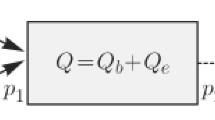Abstract
A theory of embolism based on an optimization model of blood flow is proposed and used to explain the topographic distribution of emboli in arterial trees.
Similar content being viewed by others
Abbreviations
- a:
-
initial segment of an artery prior to a bifurcation
- b:
-
smaller of two branches at a bifurcation
- p:
-
larger of two branches at a bifurcation
- n:
-
an arbitrary bifurcation in a vascular hierarchy
- r:
-
radius
- Q:
-
flow rate
- j:
-
exponent on Q, specific for type of steady flow
- x:
-
optimal branch exponent (see text)
- k:
-
optimal branch coefficient (see text)
- S:
-
probability of an embolus flowing into an arterial segment
- a,b,c,...:
-
constants; coefficients on variables
References
Altman, J.S. and D.S. Dittmer (1972). Respiration and Circulation. Federation of American Societies of Experimental Biology.
Griffith, T.M., D.H. Edwards, R.L. Davies and A.H. Henderson (1989). The role of EDRF in flow distribution: A microangiographic study of the rabbit isolated ear. Microvas. Res. 37: 162–177.
McDonald, D.A. (1960). Blood Flow in Arteries. London, Arnold Ltd.
Murray, C.D. (1926). The physiological principle of minimum work. I. The vascular system and the cost of blood volume. Proc Natl Acad. Sci. USA 12: 207–214.
Pollanen, M.S. and J.H.N. Deck (1989). Directed embolization is an alternate cause of watershed infarction. Arch. Pathol. Lab. Med. 113: 1139–1141.
Pollanen, M.S. and J.H.N. Deck(1990). The mechanism of embolic watershed infarction; Experimental studies. Can. J. Neurol. Sci. 17: 395–398.
Pollanen, M.S. (1991a). Behaviour of suspended particles at bifurcation: Implications for embolism. Phys. Med. Biol. 36: 397–401.
Pollanen, M.S. (1991b). A Hempelian explanatory shift in neuropathology: A study in the history and logic of medicine. Can. Bull. Med. Hist. 8: 65–67.
Pollanen, M.S. (1992). Dimensional optimization at different levels of the arterial hierarchy. J. theor. Biol. 159: 267–270.
Sherman, T.F. (1981). On connecting large to small: The meaning of Murray's law. J. Gen. Physiol. 78: 431–453.
Stein, P.D. and H.N. Sabbah (1976). Turbulent blood flow in the ascending aorta of humans with normal and diseased aortic valves. Circ. Res. 39: 58–65.
Torvik, A. and K. Skullerud (1982). Watershed infarcts in the brain caused by microemboli. Clin. Neuropathol. 1: 99–195.
Uylings, H.B.M. (1977). Optimization of diameters and bifurcation angles in lung and vascular tree structures. Bull. Math. Biol. 39: 509–520.
Zamir, M. (1988a). The branching structure of arterial trees. Comment Theor. Biol. 1: 15–37.
Zamir, M. (1988b). Distributing and delivering vessels of the human heart. J. Gen. Physiol. 91: 725–735.
Author information
Authors and Affiliations
Rights and permissions
About this article
Cite this article
Pollanen, M.S. On a mathematical theory of embolism. Acta Biotheor 41, 191–197 (1993). https://doi.org/10.1007/BF00712166
Received:
Issue Date:
DOI: https://doi.org/10.1007/BF00712166




